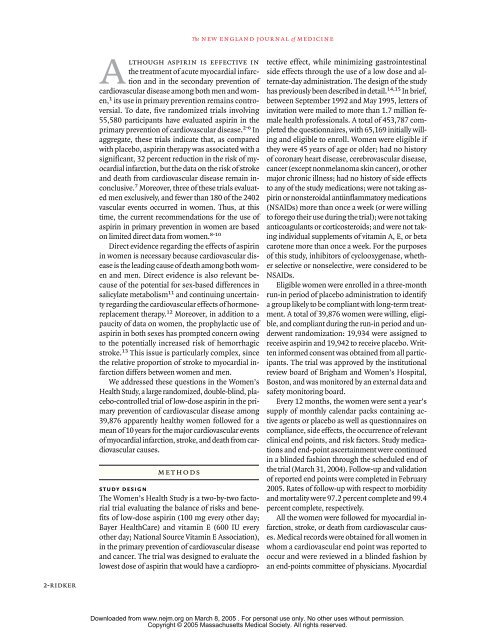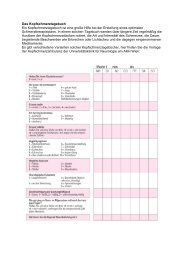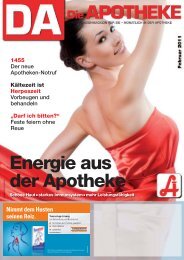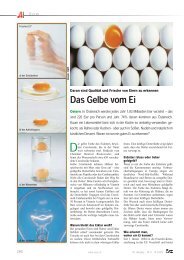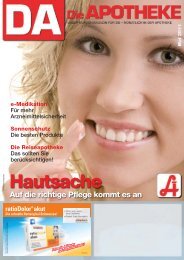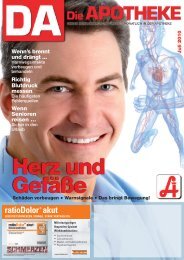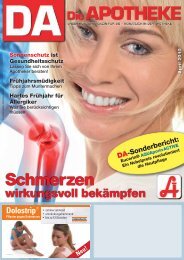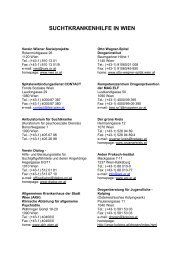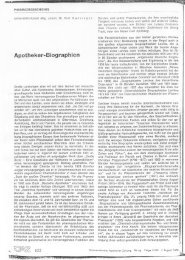The new england journal of medicine
The new england journal of medicine
The new england journal of medicine
Create successful ePaper yourself
Turn your PDF publications into a flip-book with our unique Google optimized e-Paper software.
2-ridker<br />
a<br />
lthough aspirin is effective in<br />
the treatment <strong>of</strong> acute myocardial infarction<br />
and in the secondary prevention <strong>of</strong><br />
cardiovascular disease among both men and women,<br />
1 its use in primary prevention remains controversial.<br />
To date, five randomized trials involving<br />
55,580 participants have evaluated aspirin in the<br />
primary prevention <strong>of</strong> cardiovascular disease.<br />
aggregate, these trials indicate that, as compared<br />
with placebo, aspirin therapy was associated with a<br />
significant, 32 percent reduction in the risk <strong>of</strong> myocardial<br />
infarction, but the data on the risk <strong>of</strong> stroke<br />
and death from cardiovascular disease remain in-<br />
conclusive.<br />
7<br />
<strong>The</strong> <strong>new</strong> <strong>england</strong> <strong>journal</strong> <strong>of</strong> <strong>medicine</strong><br />
n engl j med 352;13<br />
2-6<br />
In<br />
Moreover, three <strong>of</strong> these trials evaluat-<br />
ed men exclusively, and fewer than 180 <strong>of</strong> the 2402<br />
vascular events occurred in women. Thus, at this<br />
time, the current recommendations for the use <strong>of</strong><br />
aspirin in primary prevention in women are based<br />
on limited direct data from women.<br />
8-10<br />
Direct evidence regarding the effects <strong>of</strong> aspirin<br />
in women is necessary because cardiovascular disease<br />
is the leading cause <strong>of</strong> death among both women<br />
and men. Direct evidence is also relevant because<br />
<strong>of</strong> the potential for sex-based differences in<br />
salicylate metabolism11<br />
and continuing uncertainty<br />
regarding the cardiovascular effects <strong>of</strong> hormone-<br />
replacement therapy.<br />
12<br />
Moreover, in addition to a<br />
paucity <strong>of</strong> data on women, the prophylactic use <strong>of</strong><br />
aspirin in both sexes has prompted concern owing<br />
to the potentially increased risk <strong>of</strong> hemorrhagic<br />
stroke.<br />
13<br />
This issue is particularly complex, since<br />
the relative proportion <strong>of</strong> stroke to myocardial infarction<br />
differs between women and men.<br />
We addressed these questions in the Women’s<br />
Health Study, a large randomized, double-blind, placebo-controlled<br />
trial <strong>of</strong> low-dose aspirin in the primary<br />
prevention <strong>of</strong> cardiovascular disease among<br />
39,876 apparently healthy women followed for a<br />
mean <strong>of</strong> 10 years for the major cardiovascular events<br />
<strong>of</strong> myocardial infarction, stroke, and death from cardiovascular<br />
causes.<br />
methods<br />
study design<br />
<strong>The</strong> Women’s Health Study is a two-by-two factorial<br />
trial evaluating the balance <strong>of</strong> risks and benefits<br />
<strong>of</strong> low-dose aspirin (100 mg every other day;<br />
Bayer HealthCare) and vitamin E (600 IU every<br />
other day; National Source Vitamin E Association),<br />
in the primary prevention <strong>of</strong> cardiovascular disease<br />
and cancer. <strong>The</strong> trial was designed to evaluate the<br />
lowest dose <strong>of</strong> aspirin that would have a cardiopro-<br />
tective effect, while minimizing gastrointestinal<br />
side effects through the use <strong>of</strong> a low dose and alternate-day<br />
administration. <strong>The</strong> design <strong>of</strong> the study<br />
has previously been described in detail.<br />
www.nejm.org march 31,<br />
2005<br />
14,15<br />
In brief,<br />
between September 1992 and May 1995, letters <strong>of</strong><br />
invitation were mailed to more than 1.7 million female<br />
health pr<strong>of</strong>essionals. A total <strong>of</strong> 453,787 completed<br />
the questionnaires, with 65,169 initially willing<br />
and eligible to enroll. Women were eligible if<br />
they were 45 years <strong>of</strong> age or older; had no history<br />
<strong>of</strong> coronary heart disease, cerebrovascular disease,<br />
cancer (except nonmelanoma skin cancer), or other<br />
major chronic illness; had no history <strong>of</strong> side effects<br />
to any <strong>of</strong> the study medications; were not taking aspirin<br />
or nonsteroidal antiinflammatory medications<br />
(NSAIDs) more than once a week (or were willing<br />
to forego their use during the trial); were not taking<br />
anticoagulants or corticosteroids; and were not taking<br />
individual supplements <strong>of</strong> vitamin A, E, or beta<br />
carotene more than once a week. For the purposes<br />
<strong>of</strong> this study, inhibitors <strong>of</strong> cyclooxygenase, whether<br />
selective or nonselective, were considered to be<br />
NSAIDs.<br />
Eligible women were enrolled in a three-month<br />
run-in period <strong>of</strong> placebo administration to identify<br />
a group likely to be compliant with long-term treatment.<br />
A total <strong>of</strong> 39,876 women were willing, eligible,<br />
and compliant during the run-in period and underwent<br />
randomization: 19,934 were assigned to<br />
receive aspirin and 19,942 to receive placebo. Written<br />
informed consent was obtained from all participants.<br />
<strong>The</strong> trial was approved by the institutional<br />
review board <strong>of</strong> Brigham and Women’s Hospital,<br />
Boston, and was monitored by an external data and<br />
safety monitoring board.<br />
Every 12 months, the women were sent a year’s<br />
supply <strong>of</strong> monthly calendar packs containing active<br />
agents or placebo as well as questionnaires on<br />
compliance, side effects, the occurrence <strong>of</strong> relevant<br />
clinical end points, and risk factors. Study medications<br />
and end-point ascertainment were continued<br />
in a blinded fashion through the scheduled end <strong>of</strong><br />
the trial (March 31, 2004). Follow-up and validation<br />
<strong>of</strong> reported end points were completed in February<br />
2005. Rates <strong>of</strong> follow-up with respect to morbidity<br />
and mortality were 97.2 percent complete and 99.4<br />
percent complete, respectively.<br />
All the women were followed for myocardial infarction,<br />
stroke, or death from cardiovascular causes.<br />
Medical records were obtained for all women in<br />
whom a cardiovascular end point was reported to<br />
occur and were reviewed in a blinded fashion by<br />
an end-points committee <strong>of</strong> physicians. Myocardial<br />
Downloaded from www.nejm.org on March 8, 2005 . For personal use only. No other uses without permission.<br />
Copyright © 2005 Massachusetts Medical Society. All rights reserved.


